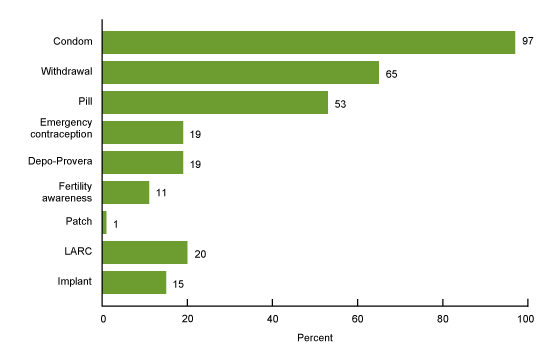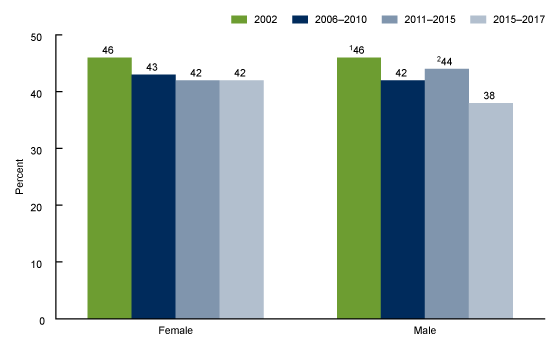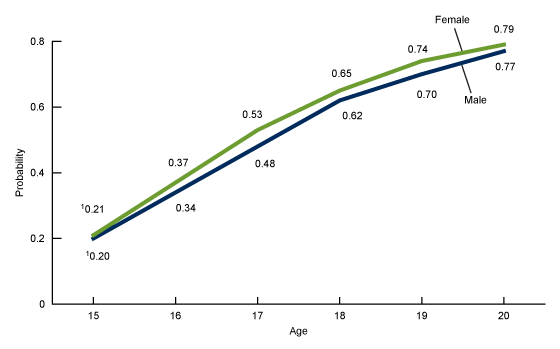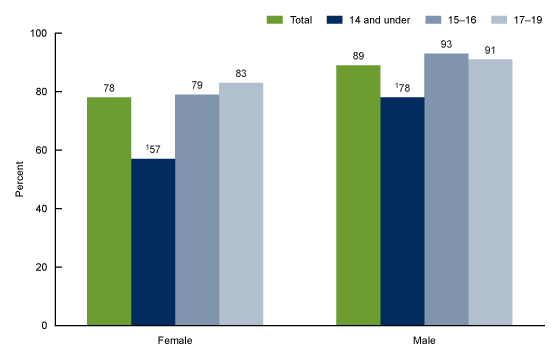Sexual Activity and Contraceptive Use Among Teenagers Aged 15–19 in the United States, 2015–2017
- Key findings
- What percentage of never-married teenagers aged 15–19 have ever had sexual intercourse?
- What is the probability of having had sexual intercourse by each age 15 through 20?
- Does the percentage of young females using contraception at first sexual intercourse differ by age at first sexual intercourse?
- What contraceptive methods have ever been used by female teenagers who have ever had sexual intercourse?
- Summary
- Definitions
- Data source and methods
- About the authors
- References
- Suggested citation
PDF Version (411 KB)
Key findings
Data from the 2015–2017 National Survey of Family Growth
- In 2015–2017, 42% of never-married female teenagers aged 15–19 and 38% of never-married male teenagers had had sexual intercourse; the percentage declined by 17% for male teenagers between 2002 and 2015–2017.
- In 2015–2017, the cumulative probabilities of having had sexual intercourse by age were similar for males and females.
- In 2015–2017, 78% of females and 89% of males aged 15–24 who had their first sexual intercourse before age 20 used a contraceptive method at first sexual intercourse.
- The condom remains the most commonly used contraceptive method among female teenagers.
Monitoring sexual activity and contraceptive use among teenagers aged 15–19 in the United States informs understanding of the risk of pregnancy. By 2018, the U.S. birth rate for teenagers dropped 72% from its peak in 1991 (1), paralleling a decline in the teen pregnancy rate (1,2). While this represents progress toward national goals, these rates are still higher than those in other developed countries (3,4). Using data from the 2002 through 2015–2017 National Survey of Family Growth (NSFG), this report provides trends and national estimates of sexual activity and contraceptive use among teenagers.
Keywords: adolescents, sexual intercourse, birth control, National Survey of Family Growth
What percentage of never-married teenagers aged 15–19 have ever had sexual intercourse?
- During 2015–2017, 42% of never-married female teenagers and 38% of never-married male teenagers had ever had sexual intercourse (Figure 1).
- The percentage of female teenagers who had ever had sexual intercourse in 2015–2017 (42%) was similar to the percentages from 2002, 2006–2010, and 2011–2015.
- Among male teenagers, the percentage who had ever had sexual intercourse declined by 17% between 2002 (46%) and 2015–2017 (38%). A significant decrease in the percentage of male teenagers who had ever had sexual intercourse was seen between 2011–2015 (44%) and 2015–2017 (38%).
Figure 1. Never-married females and males aged 15–19 who have ever had sexual intercourse: United States, 2002–2017
1Significant change from 2002 to 2015–2017 for male teenagers (p < 0.05).
2Significant change from 2011–2015 to 2015–2017 for male teenagers (p < 0.05).
NOTE: Access data table for Figure 1.
SOURCE: NCHS, National Survey of Family Growth, 2002, 2006–2010, 2011–2015, and 2015–2017.
What is the probability of having had sexual intercourse by each age 15 through 20?
- In 2015–2017, the cumulative probabilities of having had sexual intercourse by each age, 15 through 20, were similar for young males and females aged 15–24 (Figure 2).
- By age 15, 21% of young females aged 15–24 had ever had sexual intercourse. By age 17, this increased to 53% of young females, and by age 20, 79% of young females had ever had sexual intercourse.
- By age 15, 20% of young males aged 15–24 had ever had sexual intercourse. By age 17, this increased to 48% of young males, and by age 20, 77% of young males had ever had sexual intercourse.
Figure 2. Probability of having had sex by age 15, 16, 17, 18, 19, and 20 for females and males: United States, 2015–2017
1Male and female teenagers had similar cumulative probabilities of having had sex at ages 15 through 20.
NOTES: Estimates are based on females and males aged 15–24 at the time of the interview. Access data table for Figure 2.
SOURCE: NCHS, National Survey of Family Growth, 2015–2017.
Does the percentage of young females using contraception at first sexual intercourse differ by age at first sexual intercourse?
- In 2015–2017, 78% of young females and 89% of young males aged 15–24 who had sexual intercourse before age 20 used a method of contraception the first time they had sexual intercourse (Figure 3).
- A higher percentage of young females who had first sexual intercourse at ages 15–16 (79%) and 17–19 (83%) used a method of contraception at first sexual intercourse compared with those who were 14 and under at first sexual intercourse (57%).
- A higher percentage of young males who had first sexual intercourse at ages 15–16 (93%) and 17–19 (91%) used a method of contraception at first sexual intercourse compared with those who were 14 and under at first sexual intercourse (78%).
Figure 3. Use of contraception at first sexual intercourse among females and males aged 15–24 who had sexual intercourse before age 20, by age at first sex: United States, 2015–2017
1Significantly lower than the percentages for those aged 15–16 and 17–19 at first sex (p < 0.05).
NOTE: Access data table for Figure 3.
SOURCE: NCHS, National Survey of Family Growth, 2015–2017.
What contraceptive methods have ever been used by female teenagers who have ever had sexual intercourse?
- In 2015–2017, 97% of female teenagers who had ever had sexual intercourse had ever used the condom (Figure 4). The next most common methods ever used by female teenagers were withdrawal (65%) and the pill (53%).
- Among female teenagers who had ever had sexual intercourse, 19% ever used emergency contraception in 2015–2017.
- In 2015–2017, 20% of female teenagers who had ever had sexual intercourse ever used long-acting reversible contraception (LARC), which includes intrauterine device (IUD) and implant contraceptives. Implants account for most LARC use (15% ever used in 2015–2017).
Figure 4. Methods of contraception ever used among females aged 15–19 who had ever had sexual intercourse: United States,
2015–2017

NOTES: LARC is long-acting reversible contraception. Contraceptive ring and intrauterine device (IUD) are not shown because they did not meet NCHS reliability criteria. Access data table for Figure 4.
SOURCE: NCHS, National Survey of Family Growth, 2015–2017.
Summary
This Data Brief updates selected indicators of sexual activity and contraceptive use among teenagers in the United States using the most recent NSFG data available. The percentage of teenagers who have ever had sexual intercourse declined between 1988 and 2017 (5), paralleling the declines in the teen birth and pregnancy rates. The percentage of male teenagers who have ever had sexual intercourse continues to decline through the most recent time points (2011–2015 and 2015–2017). According to data for 2015–2017, the cumulative probabilities of having had sexual intercourse by each age were similar for female and male teenagers. This differs from 2011–2015, when male teenagers had a higher probability of having had sexual intercourse by age 15 and 16 than females (5). Most young adults who had their first sexual intercourse before age 20 used a method of contraception at first sexual intercourse. The methods most commonly used by female teenagers were the condom, withdrawal, and the oral contraceptive pill. Increases in ever use of emergency contraception and LARC were seen in the past 3 decades (5). Understanding these patterns and trends in sexual activity and contraceptive use can help provide context for the declines that have been seen in the U.S. birth and pregnancy rates for teenagers since the early 1990s.
Definitions
Age at first sexual intercourse: The recode variable VRY1STAG indicates the respondent’s age at first sexual (vaginal) intercourse.
Contraceptive methods ever used: These data are based on a series of yes or no questions asking the female respondent if she has ever used each of 19 different contraceptive methods. The following are the contraceptive methods included in this series: pill; condom; partner’s vasectomy; Depo-Provera injectable; withdrawal; fertility awareness-based methods (i.e., rhythm method or natural family planning); contraceptive patch; contraceptive ring; emergency contraception; hormonal implant; IUD; cervical cap; diaphragm; female condom, vaginal pouch; foam; jelly or cream; suppository, insert; Today sponge; and other method.
Probability of first sexual intercourse by selected ages: The probability that an individual has experienced first sexual intercourse by various ages was calculated using the Kaplan–Meier procedure using SUDAAN software (https://www.rti.org/sudaan). This methodology uses age-specific rates to calculate how many individuals of a cohort will experience an event (e.g., first sexual intercourse) during an interval. These probabilities do not represent the actual percentages of individuals who have had sex by each age shown; instead, they represent how likely it is that an individual will have had sex by a specified age, given the age-specific first sex rates observed for this NSFG-based cohort. For example, a probability of first sex of 0.78 by age 20 for male teenagers means that by age 20 there is a 78% probability that they will have had sexual intercourse for the first time.
Sexual experience: The recode variable HADSEX indicates whether the respondent ever had vaginal sexual intercourse, referred to in this report simply as sexual intercourse.
Used a contraceptive method at first sexual intercourse: The recode variable SEX1MTHD1 indicates whether any contraceptive method was used at first sexual intercourse, and if so, what method(s).
Data source and methods
This report is based on data from 924 female and 886 male teenagers aged 15–19 who were interviewed in the 2015–2017 NSFG. For Figures 2 and 3, analyses included an additional 744 females and 640 males aged 20–24. These additional cases were included to increase sample size because: (a) some of those aged 15–19 who have not experienced these events may do so before age 20; and (b) those aged 20–24 have completed their teenage years, and because some questions ask for retrospective information, such as the respondent’s age at key events, they can provide information on whether they experienced these events in their teenage years. Selected trends are presented using data from three other data collection periods of NSFG (2002, 2006–2010, and 2011–2015).
The trend in the percentage of teenagers who have ever had sexual intercourse (Figure 1) is limited to never-married teenagers. However, given the rarity of marriage among teenagers in the United States during this time (1%–2% of female teenagers and 0.23%–0.40% of male teenagers), limiting the estimates shown in Figures 2–4 to never-married teenagers would have made little impact on the estimates (6,7).
NSFG provides detailed information about sexual intercourse, contraceptive use, and the timing of childbearing among U.S. women aged 15–49. All estimates in this report were weighted to reflect the household population of the United States at the midpoint of 2015–2017 interviewing (July 2016). The response rate in 2015–2017 for female teenagers was 67.8% and for male teenagers was 65.6%.
Statistics for this report were produced using the SURVEY procedures in SAS software version 9.4. The probabilities of first sexual intercourse (Figure 2) were produced using the Kaplan–Meier procedure in SUDAAN. Percentages were compared using two-tailed t tests at the 5% level. No adjustments were made for multiple comparisons. The data presented in this report are bivariate associations that may be explained by other factors not controlled for in the figures or included in the report.
About the authors
Gladys M. Martinez and Joyce C. Abma are with the National Center for Health Statistics, Division of Vital Statistics, Reproductive Statistics Branch.
References
- Hamilton BE, Martin JA, Osterman MJK, Rossen LM. Births: Provisional data for 2018. Vital Statistics Rapid Release; no 7. Hyattsville, MD: National Center for Health Statistics. May 2019.
- Kost K, Maddow-Zimet I, Arpaia A. Pregnancies, births and abortions among adolescents and young women in the United States, 2013: National and state trends by age, race and ethnicity. New York: Guttmacher Institute. 2017.
- U.S. Department of Health and Human Services, Office of Disease Prevention and Health Promotion. Healthy People 2020. Washington, DC. Family planning.
- Sedgh G, Finer LB, Bankole A, Eilers MA, Singh S. Adolescent pregnancy, birth, and abortion rates across countries: Levels and recent trends. J Adolesc Health 56(2):223–30. 2015.
- Abma JC, Martinez GM. Sexual activity and contraceptive use among teenagers in the United States, 2011–2015. National Health Statistics Reports; no 104. Hyattsville, MD: National Center for Health Statistics. 2017.
- Chandra A, Martinez GM, Mosher WD, Abma JC, Jones J. Fertility, family planning, and reproductive health of U.S. women: Data from the 2002 National Survey of Family Growth. National Center for Health Statistics. Vital Health Stat 23(25). 2005.
- Martinez GM, Chandra A, Abma JC, Jones J, Mosher WD. Fertility, contraception, and fatherhood: Data on men and women from Cycle 6 (2002) of the National Survey of Family Growth. National Center for Health Statistics. Vital Health Stat 23(26). 2006.
Suggested citation
Martinez GM, Abma JC. Sexual activity and contraceptive use among teenagers aged 15–19 in the United States, 2015–2017. NCHS Data Brief, no 366. Hyattsville, MD: National Center for Health Statistics. 2020.
Copyright information
All material appearing in this report is in the public domain and may be reproduced or copied without permission; citation as to source, however, is appreciated.
National Center for Health Statistics
Jennifer H. Madans, Ph.D., Acting Director
Amy M. Branum, Ph.D., Acting Associate Director for Science
Division of Vital Statistics
Steven Schwartz, Ph.D., Director
Isabelle Horon, Dr.P.H., Acting Associate Director for Science


